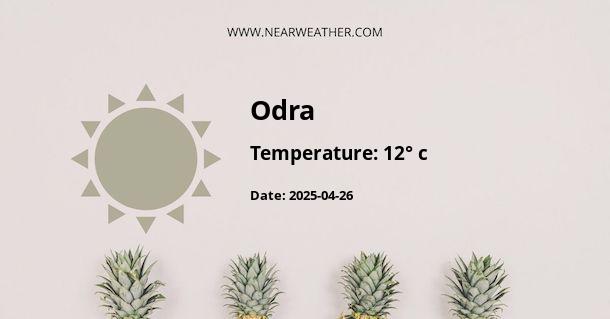Understanding the Climate and Weather Patterns in Odra, HR
In the heart of Europe lies Odra, a picturesque locale in Croatia known for its rich cultural heritage and breathtaking landscapes. Odra is not only a tourist attraction but also a place where understanding the climate and weather patterns is essential for those looking to visit or live there. This guide provides a comprehensive overview of Odra's climate and its weather dynamics throughout the year.
Odra's Geographical Climate Classification
Odra, situated in Croatia, falls under the Köppen climate classification, specifically featuring a Continental climate, with long, warm summers and chilly, snowy winters. Such a climate is characterized by a significant temperature variation between summer and winter months.
Seasonal Weather in Odra: A Detailed Analysis
Winter
December to February - Odra experiences a cold and snowy winter. During these months, average temperatures range from below freezing to about 5°C. Snowfall is common, transforming the landscape into a winter wonderland, which, while beautiful, requires adequate preparations for residents and visitors alike regarding heating and transportation.
| Month | Average High | Average Low | Precipitation/Snowfall |
|---|---|---|---|
| December | 3°C | -1°C | 80 mm / 40 cm |
| January | 2°C | -3°C | 70 mm / 50 cm |
| February | 4°C | -2°C | 65 mm / 45 cm |
Spring
March to May - As winter thaws, Odra's springs are characterized by a gradual rise in temperature. Rainfall increases, fueling the growth of the verdant landscapes. Ideal for nature enthusiasts, this season is marked by moderate weather, with temperatures ranging from 8°C to 21°C.
| Month | Average High | Average Low | Precipitation |
|---|---|---|---|
| March | 11°C | 3°C | 70 mm |
| April | 16°C | 8°C | 60 mm |
| May | 21°C | 12°C | 75 mm |
Summer
June to August - The summer season in Odra is warm and generally sunny. Occasional heat waves can push temperatures above 30°C. While summer offers optimal conditions for outdoor activities and tourism, the threat of thunderstorms and higher humidity levels calls for preparedness against sudden weather changes.
| Month | Average High | Average Low | Precipitation |
|---|---|---|---|
| June | 25°C | 15°C | 100 mm |
| July | 28°C | 17°C | 80 mm |
| August | 27°C | 17°C | 85 mm |
Autumn
September to November - Autumn ushers in a cool and breezy atmosphere, with a significant decrease in temperature and daylight hours. The landscape becomes a canvas of russet and golden hues, and residents often experience the first frost by late November. This time of the year the region can be prone to fog, particularly in the morning hours.
| Month | Average High | Average Low | Precipitation |
|---|---|---|---|
| September | 22°C | 13°C | 90 mm |
| October | 16°C | 9°C | 85 mm |
| November | 11°C | 4°C | 100 mm |
Extreme Weather and Climate Events in Odra
Like much of Croatia, Odra is susceptible to extreme weather events, which include severe thunderstorms, flash flooding, and even drought conditions during extended periods without rain in the summer months. In the face of climate change, these extremes may become more pronounced or frequent. It is advised to consistently monitor local weather forecasts and adhere to any warnings issued by meteorological services.
Monthly Sunshine and Daylight Hours
The amount of sunshine in Odra varies significantly over the course of the year, with long, sunny days in summer and shorter days in winter due to its northern latitude. Here's an average estimate of daylight hours and sunshine throughout the year:
- December & January: 2-3 hours of sunshine per day
- February: 3-4 hours
- March: 4-6 hours
- April & May: 6-8 hours
- June & July: 8-10 hours
- August: 7-9 hours
- September: 6-7 hours
- October: 4-5 hours
- November: 3-4 hours
Preparing for Weather Fluctuations in Odra
When planning activities or a visit to Odra, it's crucial to consider the region's diverse climate. In winter, pack warm clothing, including layers that can be easily adjusted to suit the indoor and outdoor temperature changes. During the summer, lightweight, breathable clothing, sunglasses, and sunscreen are essential due to the risk of heat waves and strong sun. Always have an umbrella or a raincoat handy, as rainfall can occur throughout the year.
Residents must prepare for seasonal changes by investing in home insulation for the cold months and fans or air conditioning to manage summer heat. Planning for adequate water storage and irrigation can also mitigate the impact of summer dry spells on agriculture and personal gardens.
Climate Adaptation and Sustainability Efforts
Odra's local government and community are actively involved in climate adaptation and sustainability efforts. These include initiatives to reduce carbon emissions, enhance green spaces, and improve water conservation. An increase in renewable energy sources such as solar and wind is also a key component of the region's push towards a more sustainable future.
Conclusion
The climate and weather patterns in Odra, HR offer a dynamic experience for its residents and visitors, featuring drastic seasonal changes and a variety of weather conditions. Understanding these patterns is not only crucial for daily life and planning but also for the long-term sustainability of the community. By remaining aware and prepared, one can fully appreciate the beauty and diversity that Odra's climate has to offer.
A - Odra's Latitude is 45.733330 & Longitude is 16.000000.
A - Weather in Odra is 12° today.
A - Climate Conditions in Odra shows overcast clouds today.
A - Humidity in Odra is 94% today.
A - Wind speed in Odra is 14.83 km/h, flowing at 40° wind direction. today.
